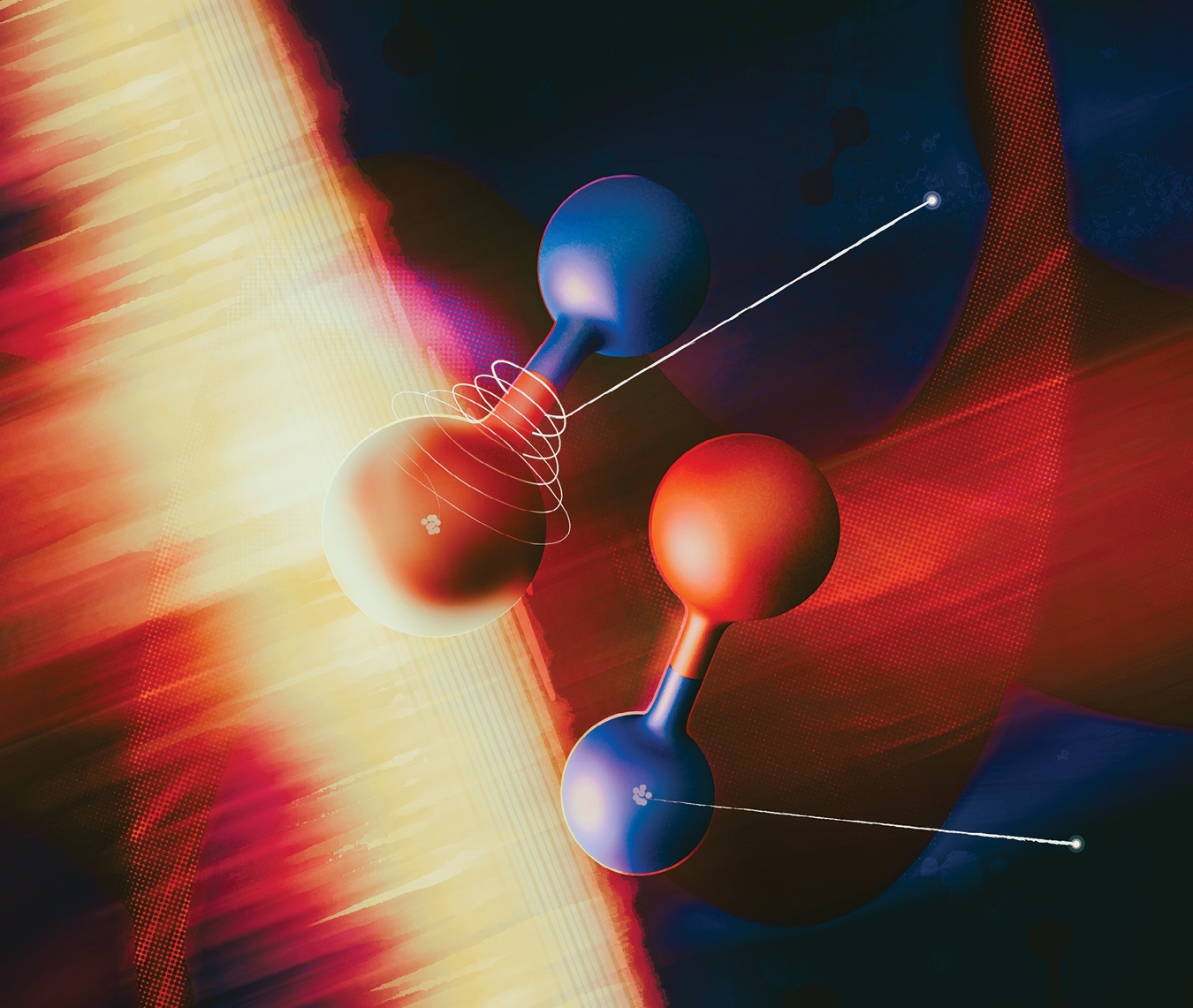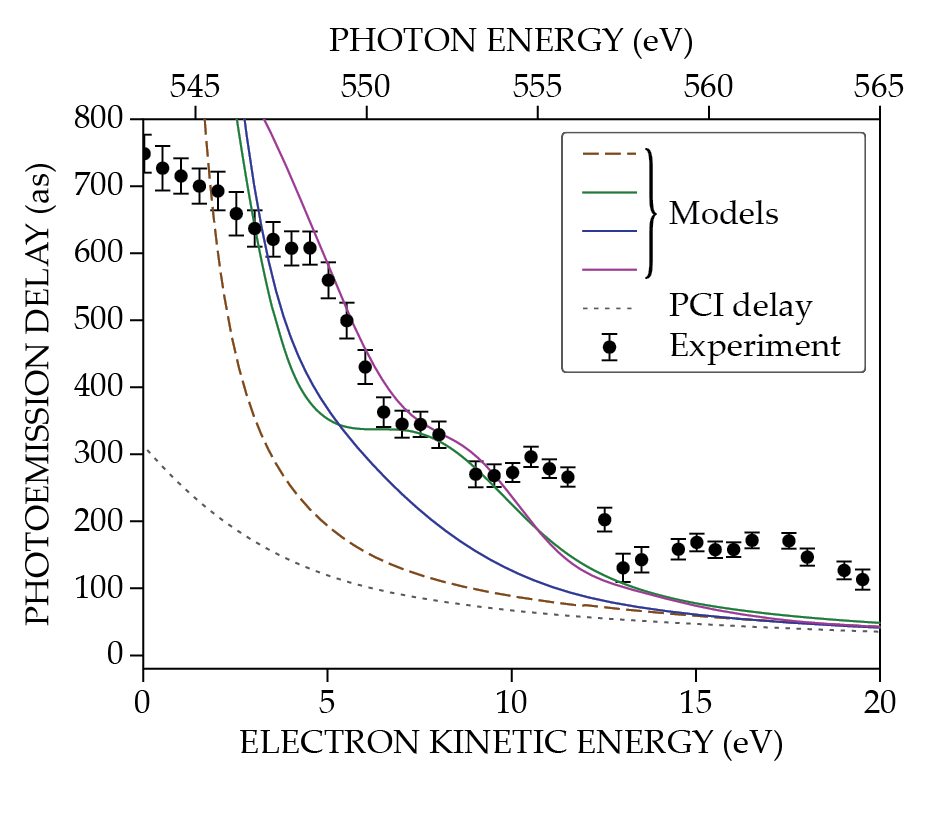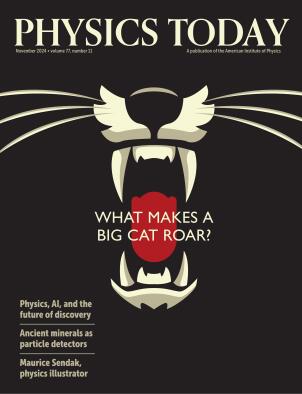Photoemission of core-level electrons is caught in the act
DOI: 10.1063/pt.fjzd.cxhc
Electrons move on the time scale of attoseconds, each of which is a vanishingly short billionth of a billionth of a second. For many years, electron motion was unobservable because no laser was capable of producing pulses of light shorter than a few femtoseconds. The ability to measure motion on such time scales is determined by the duration of the laser pulses: If the pulse lengths are too long, the motion can’t be calculated with sufficient precision.
At the turn of this century, the attosecond limit was broken by two groups—one led by Pierre Agostini and another by Ferenc Krausz—both of which relied on earlier nonlinear-optics results from Anne L’Huillier and colleagues. For their experimental contributions, the three researchers received the 2023 Nobel Prize in Physics (see Physics Today, December 2023, page 13
Using ultrafast pulses of light generated from tabletop lasers, the researchers made many observations of processes that were once considered instantaneous. In 2010, for example, Krausz and colleagues found that the photoionization of valence electrons in neon took tens of attoseconds. 1 A follow-up experiment in 2017 led by L’Huillier refined the timing further. 2
Complex multielectron interactions can be studied with measurements of core electrons—those closest to an atom’s nucleus. But their motion and interactions on the attosecond time scale have remained out of reach. The binding energies of such electrons are too high to be studied with attosecond pulses of light from low-energy tabletop lasers.
Now Stanford University’s Taran Driver, Agostino Marinelli, and James Cryan and their colleagues have harnessed recent advances in x-ray free-electron lasers (XFELs) to witness the photoelectric effect in core electrons.
3
The new measurement technique, illustrated in figure
Figure 1.

An ultrafast pulse of bright x-ray light bombards two nitric oxide molecules, initiating photoionization. The time at which the molecules’ core electrons (white dots) are emitted can be inferred from the angle at which they are deflected by a circularly polarized IR laser field. (Courtesy of Gregory M. Stewart, SLAC National Accelerator Laboratory.)

Shorter, brighter waves
The workhorses of attosecond experiments are the ultrafast light pulses created by high harmonic generation (HHG). An intense IR laser illuminates a target, usually an atomic or molecular gas, whose electrons are then excited and emit higher-frequency harmonics of the driving laser. With such a source, researchers can produce pulses of extreme UV (XUV) light as short as dozens of attoseconds. (For more on HHG, see the article by Paul Corkum, Physics Today, March 2011, page 36
The XUV pulses produced via HHG have high-enough photon energies to excite valence electrons and short-enough durations for researchers to measure the time scale of the electrons’ motion. Exciting core electrons, however, requires soft x rays, which have higher energies than XUV photons but not quite as high as that of hard x rays used for medical imaging. Recent efforts have succeeded in producing HHG-based sources at x-ray wavelengths. But the number of photons in an ultrafast pulse decreases as the photon energy increases. That limitation has prevented researchers from using HHG-based sources to study the photoionization of core electrons.
An alternative source of ultrafast pulses is the XFEL. The kilometer-sized instrument sends a bunch of relativistic electrons through a series of alternating magnets to generate femtosecond x-ray pulses. Compared with tabletop lasers, XFEL sources have several advantages. For example, they generate much more intense pulses of light with a broad range of tunable wavelengths. In addition, the pulse bandwidth is small enough that researchers can home in on particular spectral features of samples.
To create XFEL pulses on the attosecond scale, Alexander Zholents (now at Argonne National Laboratory) proposed a technique in 2005 called enhanced self-amplified spontaneous emission. 4 The resonant interaction of a high-power IR laser with the XFEL electron beam creates an ultrashort current spike in the beam, which could then be used to generate an x-ray pulse that lasts just a few hundred attoseconds.
The type of laser that the method relied on turned out to have many practical and technical challenges. “While these ideas had broad support in the community,” says Marinelli, “nobody really knew how to realize them in an experiment, and to this day, nobody has done so. Between 2005 and 2015, not much happened.”
Slower than expected
Marinelli studied alternative approaches, and by 2019, he and colleagues had developed a working technique for the Linac Coherent Light Source at SLAC. They realized that rather than using an external IR beam, as Zholents had proposed, they could use the IR radiation emitted in the tail of the XFEL electron beam. The result was a beam with a single high-current spike that generated an isolated attosecond pulse. 5
Equipped with the necessary attosecond pulses, the researchers measured the photoionization of core electrons in gaseous nitric oxide. Marinelli says, “We did this measurement only a few days after the first-ever demonstration of isolated attosecond soft x-ray pulses at an XFEL.”
They made the measurement with the angular-streaking method, 6 in which an ionizing attosecond x-ray pulse is overlapped with a circularly polarized IR laser field. The rotating electric field of the IR laser deflects the photoionized electrons radially, and the time at which the electron is emitted from the molecule can be calculated from the deflection angle.
The new measurement is the first time an attosecond XFEL source was used to measure photoemission delays, and the research team spent a lot of time designing the data analysis, which included a helpful mathematical model by Jun Wang. “To understand what our data were telling us,” says Cryan, “we also had to work closely with our theory collaborators, who simulated the physical effects that we had observed.”
The timing of the photoionization is defined by the delay of the core electron’s ejection relative to a reference event. Compared with the emission of 120 eV valence electrons from the molecule, the oxygen atom’s core electrons—with kinetic energies no higher than 20 eV—were emitted as much as 700 attoseconds later, as seen in figure
Figure 2.

Hundreds of attoseconds is the time it takes for a core electron to be emitted from the shell closest to the oxygen nucleus in a photoionized nitric oxide molecule. To observe such a fleeting event, researchers measured the time delay between the emission of two electrons, which were ejected by an attosecond pulse of light from an x-ray free-electron laser. Especially at the lower and upper ranges of electron kinetic energies, the experimental results differ from model calculations. Some delay (black dotted line) is due to the ejected core electron’s postcollision interaction (PCI) with another electron. (Adapted from ref.

When electrons meet
Valence electrons are critical for molecular reactions, but the study of core electrons can reveal other processes. On their way out of a molecule, ionized core electrons can interact with the more weakly bound valence electrons. In fact, the researchers’ numerical simulations show that some of the core electrons’ delay, plotted in figure
Once it’s emitted from its shell, a core electron, unlike a valence electron, is quickly replaced by an electron in a higher-energy orbital farther from the nucleus. Through a process known as Auger–Meitner decay, the energy released when a core vacancy is filled gets transferred to a valence electron, which is then emitted from the molecule after a few femtoseconds.
“Collisions with Auger electrons have not been observed before in photoemission delay experiments,” says Kevin Prince, a senior scientist at the Elettra Sincrotrone Trieste research center in Italy. “Multielectron scattering is also new in this context.”
Theoretical models have struggled to accurately predict photoemission delay at the lowest electron kinetic energies; figure
References
1. M. Schultze et al., Science 328, 1658 (2010). https://doi.org/10.1126/science.1189401
2. M. Isinger et al., Science 358, 893 (2017). https://doi.org/10.1126/science.aao7043
3. T. Driver et al., Nature 632, 762 (2024). https://doi.org/10.1038/s41586-024-07771-9
4. A. A. Zholents, Phys. Rev. Accel. Beams 8, 040701 (2005). https://doi.org/10.1103/PhysRevSTAB.8.040701
5. J. Duris et al., Nat. Photon. 14, 30 (2020). https://doi.org/10.1038/s41566-019-0549-5
6. P. Eckle et al., Nat. Phys. 4, 565 (2008). https://doi.org/10.1038/nphys982
More about the Authors
Alex Lopatka. alopatka@aip.org

